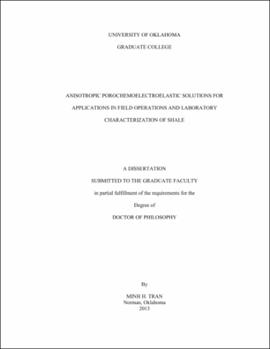| dc.contributor.advisor | Abousleiman, Younane N | |
| dc.creator | Tran, Minh Ha | |
| dc.date.accessioned | 2019-04-27T21:38:49Z | |
| dc.date.available | 2019-04-27T21:38:49Z | |
| dc.date.issued | 2013 | |
| dc.identifier | 9952340902042 | |
| dc.identifier.uri | https://hdl.handle.net/11244/319253 | |
| dc.description.abstract | In this study, the porochemoelectroelastic formulation is explained in details and fully expanded to capture the well known anisotropic nature of shale. The formulation is then applied to derive the analytical solutions for rectangular strip sample, cylindrical sample, and inclined wellbore under various loading and in-situ conditions while being exposed to an external fluid. The newly-derived solutions can be considered as necessary extensions of some existing analytical solutions to capture the anisotropic and chemically active nature of shale formations. Numerical examples are also included to illustrate the applications of the derived solutions in shale formations. The results show that ignoring either the porochemoelectroelastic behavior or the anisotropic characteristic of the shale formation will mislead the predictions and assessment of potential problems in laboratory and field operations. | |
| dc.description.abstract | In particular, the presence of negative fixed charges on the surface of clay minerals creates an osmotic pressure at the interface of the sample and the external fluid with magnitude proportional to the CEC of the sample. This Donnan-induced pore pressure when coupled with the load-generated pore pressure and the activity-generated pore pressure can result in significant tensile effective stresses and tensile damages in the shale. The results, thus, explain why some shales disintegrate when brought into contact with certain aqueous solutions while others do not. | |
| dc.description.abstract | Practical implications for field operations have been drawn for both wellbore drilling and hydraulic fracturing. The analyses show clearly that the effective tangential stresses and, hence, the axial stresses around a wellbore are greatly affected by the formation anisotropic mechanical parameters. In addition, during drilling, the chemically-induced tensile effective radial stress and tangential stress can lead to wellbore spalling which in extreme cases may result in stuck pipe. On the other hand, during hydraulic fracturing, these induced tensile damages can weaken the shale formation leading to a wider fracture width and a shorter fracture length during the fracturing process. In addition, the damaged and weakened formation can exacerbate the problem of proppant embedment resulting in larger fracture closure and reduction of fracture length and productivity. Thus, the results explain why higher clay content intervals are often reported to be more "ductile" compared to lower clay content intervals. Moreover, the use of drilling mud and fracturing fluid having activity similar to the shale formation native pore fluid can help to prevent wellbore spalling and work for the advantage of the fracturing process. | |
| dc.description.abstract | In the laboratory testing context, these complex pore pressure, stresses responses and distributions can complicate the interpretation of experimental results for the effects of fluid chemistry on the rock matrix. Practically, it is recommended to gradually adjust the testing fluid salt concentration or applied load to the desired value so that excessive induced stress and pore pressure buildup inside the tested sample become minimal. | |
| dc.description.abstract | Finally, analysis for shale electrokinetic effects on pore pressure buildup during diagenesis suggests that, in addition to the intrinsically low permeability of shale, the semi-permeable membrane behavior of the clay matrix can effectively hinder the overall pore fluid diffusion process. As a result, the pore pressure buildup inside a shale formation can be much higher than in a clean sand formation under the same consolidation rate. Hence, taking into account shale electrokinetic effects in basin modeling may give better predictions of overpressure issues in shale. | |
| dc.format.extent | 123 pages | |
| dc.format.medium | application.pdf | |
| dc.language | en_US | |
| dc.relation.requires | Adobe Acrobat Reader | |
| dc.subject | Shale--Testing | |
| dc.subject | Oil-shales | |
| dc.subject | Geochemistry | |
| dc.subject | Petrology | |
| dc.title | ANISOTROPIC POROCHEMOELECTROELASTIC SOLUTIONS FOR APPLICATIONS IN FIELD OPERATIONS AND LABORATORY CHARACTERIZATION OF SHALE | |
| dc.type | text | |
| dc.type | document | |
| dc.thesis.degree | Ph.D. | |
| ou.group | Mewbourne College of Earth and Energy::Mewbourne School of Petroleum and Geological Engineering | |
